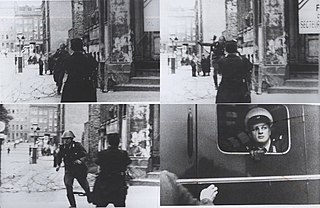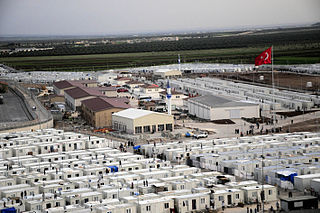Related Research Articles
The United Nations High Commissioner for Refugees (UNHCR) is a United Nations agency mandated to aid and protect refugees, forcibly displaced communities, and stateless people, and to assist in their voluntary repatriation, local integration or resettlement to a third country. It is headquartered in Geneva, Switzerland, with over 18,879 staff working in 138 countries.

A refugee, conventionally speaking, is a person who has lost the protection of their country of origin and who cannot or is unwilling to return there due to well-founded fear of persecution. Such a person may be called an asylum seeker until granted refugee status by the contracting state or the United Nations High Commissioner for Refugees (UNHCR) if they formally make a claim for asylum.
An asylum seeker is a person who leaves their country of residence, enters another country and applies for asylum in that other country. An asylum seeker is an immigrant who has been forcibly displaced and might have fled their home country because of war or other factors harming them or their family. If their case is accepted, they become considered a refugee. The terms asylum seeker, refugee and illegal immigrant are often confused.
In international law, a stateless person is someone who is "not considered as a national by any state under the operation of its law". Some stateless people are also refugees. However, not all refugees are stateless, and many people who are stateless have never crossed an international border. On November 12, 2018, the United Nations High Commissioner for Refugees stated there are about 12 million stateless people in the world.
Refugee law is the branch of international law which deals with the rights and duties states have vis-a-vis refugees. There are differences of opinion among international law scholars as to the relationship between refugee law and international human rights law or humanitarian law.

The Dublin Regulation is a European Union (EU) law that determines which EU Member State is responsible for the examination of an application for asylum, submitted by persons seeking international protection under the Geneva Convention and the EU Qualification Directive, within the European Union. It is the cornerstone of the Dublin System, which consists of the Dublin Regulation and the EURODAC Regulation, which establishes a Europe-wide fingerprinting database for unauthorised entrants to the EU. The Dublin Regulation aims to "determine rapidly the Member State responsible [for an asylum claim]" and provides for the transfer of an asylum seeker to that Member State.

Parole, in the immigration laws of the United States, generally refers to official permission to enter and remain temporarily in the United States, under the supervision of the U.S. Department of Homeland Security (DHS), without formal admission, and while remaining an applicant for admission.

A refugee travel document is a travel document issued to a refugee by the state in which they normally reside in allowing them to travel outside that state and to return there. Refugees are unlikely to be able to obtain passports from their state of nationality and therefore need travel documents so that they might engage in international travel.

Immigration to Turkey is the process by which people migrate to Turkey to reside in the country. Many, but not all, become Turkish citizens. After the dissolution of the Ottoman Empire and following Turkish War of Independence, an exodus by the large portion of Turkish (Turkic) and Muslim peoples from the Balkans, Caucasus, Crimea, and Greece took refuge in present-day Turkey and moulded the country's fundamental features. Trends of immigration towards Turkey continue to this day, although the motives are more varied and are usually in line with the patterns of global immigration movements. Turkey's migrant crisis is a following period since the 2010s, characterized by high numbers of people arriving and settling in Turkey.

The International Catholic Migration Commission (ICMC) is an international organization that serves and protects uprooted people, including migrants, refugees, and internally displaced people, regardless of faith, race, ethnicity or nationality. With staff and programs in over 40 countries, ICMC advocates for sustainable solutions and rights-based policies directly and through a worldwide network of 132 member organizations.
Refugees in New Zealand have two main pathways for gaining protection in the country. Asylum seekers may seek protection after arrival in New Zealand. Refugees may also be resettled from offshore through New Zealand's Refugee Quota Programme. In 2017/18 a community sponsorship pathway was trialled, extended from 2021.Refugees who have been resettled can apply to sponsor relatives to join them, though those being sponsored need not be refugees themselves

The Convention Relating to the Status of Stateless Persons is a 1954 United Nations multilateral treaty that aims to protect stateless individuals.

Nationals of many countries may visit Brazil without a visa, while others must obtain a visa from one of the Brazilian diplomatic missions. For stays longer than 90 days or for employment in Brazil, all foreign nationals must have a visa or residency authorization.
Afghan diaspora refers to the Afghan people that reside and work outside of Afghanistan. They include natives and citizens of Afghanistan who have immigrated to other countries. The majority of the diaspora has been formed by Afghan refugees since the start of the Soviet–Afghan War in 1979; the largest numbers temporarily reside in Iran and Pakistan. As stateless refugees or asylum seekers, they are protected by the well-established non-refoulement principle and the U.N. Convention Against Torture. The ones having at least one American parent are further protected by United States laws.
Refugees of the Syrian Civil War are citizens and permanent residents of Syria who have fled the country throughout the Syrian Civil War. The pre-war population of the Syrian Arab Republic was estimated at 22 million (2017), including permanent residents. Of that number, the United Nations (UN) identified 13.5 million (2016) as displaced persons, requiring humanitarian assistance. Of these, since the start of the Syrian Civil War in 2011 more than six million (2016) were internally displaced, and around five million (2016) had crossed into other countries, seeking asylum or placed in Syrian refugee camps worldwide. It is often described as one of the largest refugee crises in history.
Asylum in Australia has been granted to many refugees since 1945, when half a million Europeans displaced by World War II were given asylum. Since then, there have been periodic waves of asylum seekers from South East Asia and the Middle East, with government policy and public opinion changing over the years.

The Re-entry Permit is a travel document similar to a certificate of identity, issued by the United States Citizenship and Immigration Services to U.S. lawful permanent residents to allow them to travel abroad and return to the United States. It is a passport-like booklet with a blue-green cover with the words Travel Document displayed prominently on its cover. Individuals whose application for permanent residency has not yet been approved can instead apply for advance parole.

Voluntary return or voluntary repatriation is usually the return of an illegal immigrant or over-stayer, a rejected asylum seeker, a refugee or displaced person, or an unaccompanied minor; sometimes it is the emigration of a second-generation immigrant who makes an autonomous decision to return to their ethnic homeland when they are unable or unwilling to remain in the host country.
The migration and asylum policy of the European Union is within the area of freedom, security and justice, established to develop and harmonise principles and measures used by member countries of the European Union to regulate migration processes and to manage issues concerning asylum and refugee status in the European Union, in particular in the Schengen Area.
Federal policy oversees and regulates immigration to the United States and citizenship of the United States. The United States Congress has authority over immigration policy in the United States, and it delegates enforcement to the Department of Homeland Security. Historically, the United States went through a period of loose immigration policy in the early-19th century followed by a period of strict immigration policy in the late-19th and early-20th centuries. Policy areas related to the immigration process include visa policy, asylum policy, and naturalization policy. Policy areas related to illegal immigration include deferral policy and removal policy.
References
- ↑ Findlaw Australia article:What are the Types of Humanitarian Visas Available in Australia?
- 1 2 EMN Belgian National Contact Point. December 2016. "Resettlement and Humanitarian Admission in Belgium." European Migration Network and the European Union. Retrieved 2020 December 7.
- ↑ "Humanitarian visas (European Union)" (PDF). europarl.europa.eu. 2018. Retrieved 2021-10-25.
- ↑ Swiss Red Cross. "Humanitäre Visa – Informationen". Schweizerisches Rotes Kreuz (in German). Retrieved 2021-10-25.
- ↑ Russian Visa Center, USA advice page
- ↑ "Programa Siria [Google translate]." Buenos Aires: Ministerio de Relaciones Exteriores, Comercio Internacional y Culto. Retrieved 2020 December 7.
- 1 2 "Action Fiche for Strengthening international protection, reception and integration of refugees in Argentina." Commission Implementing Decision on the 2017 Annual Action programme for the Partnership Instrument, annex 21. Service for Foreign Policy Instruments, European Commission. 2017.
- ↑ Decree no. 9.199, of 20 November 2017, Government of Brazil (in Portuguese).
- ↑ Interministerial ruling no. 24, of 3 September 2021, Ministry of Justice of Brazil. (in Portuguese)
- ↑ Interministerial ruling MJSP/MRE no. 27, of 30 December 2021, Ministry of Justice of Brazil. (in Portuguese)
- ↑ Interministerial ruling no. 9, of 8 October 2019, Ministry of Justice of Brazil. (in Portuguese)
- ↑ Interministerial ruling MJSP/MRE no. 28, of 3 March 2022, Ministry of Justice of Brazil. (in Portuguese)
- ↑ USA Today, What Is a Humanitarian Visa?